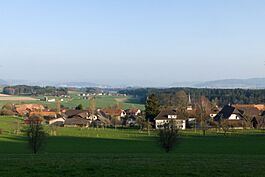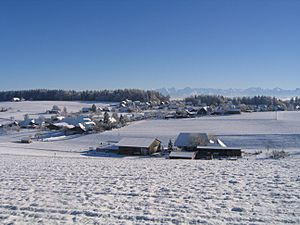Meikirch facts for kids
Quick facts for kids
Meikirch
|
||
|---|---|---|

Meikirch village
|
||
|
||
| Country | Switzerland | |
| Canton | Bern | |
| District | Bern-Mittelland administrative district | |
| Area | ||
| • Total | 10.23 km2 (3.95 sq mi) | |
| Elevation | 654 m (2,146 ft) | |
| Population
(Dec 2020 )
|
||
| • Total | 2,526 | |
| • Density | 246.92/km2 (639.5/sq mi) | |
| Postal code |
3045
|
|
| Surrounded by | Kirchlindach, Schüpfen, Seedorf, Wohlen bei Bern | |
Meikirch is a small town, also called a municipality, in the canton of Bern in Switzerland. It's part of the Bern-Mittelland administrative district.
Contents
History of Meikirch
Meikirch was first written about in the year 1208. Back then, it was called Mönchilcha.
Ancient Times and Early Settlements
Long ago, people lived in the Meikirch area. We know this from old sites found in Grächwil. These sites show signs of the Hallstatt culture, which was an important time in the Iron Age. There was also a Roman estate, like a large farm or villa, in Meikirch. It even had wall paintings!
Medieval and Early Modern Periods
The modern village of Meikirch began with a monastery called Frienisberg. This monastery owned the land. Later, in the 1200s and 1300s, the Bernburg family from Bolligen owned the village. In the 1500s, the Aebischer family, who were important leaders called Schultheisses in Aarberg, owned Meikirch. In 1555, the Aebischer family sold the village to the city of Bern.
The Village Church
The village church was first mentioned in 1275. However, it was actually built much earlier, between the 600s and 700s AD. It was built right on top of the old Roman villa ruins. Parts of the very old church buildings are still there today, even after many changes. The church tower is from the 1100s. In 1528, after the Protestant Reformation (a big change in Christianity), the church became part of Bern's authority.
Changes Over Time
After the French invasion in 1798, Meikirch became part of the Zollikofen District. A few years later, it moved to the Aarberg District. Meikirch was on an important road between Bern, Frienisberg, and Aarberg. It was even part of the postal route in the 1700s and 1800s.
However, a new road was built in 1851-52 that went around Meikirch. This caused the population to shrink after 1850. The decline got even bigger after World War I. During this time, local farms changed from growing grain to raising cattle and dairy. This type of farming needed fewer people, so many villagers left Meikirch.
The population started to grow again when transportation improved. In 1948, a Postauto (bus) route to Bern began. Then, in 1960, a new road to Bern was finished. Old village houses were rebuilt, and new areas like Schützenrain, Weissenstein, and Neu-Grächwil were built for new residents. The Meikirch secondary school opened in 1974.
Geography of Meikirch
Meikirch covers an area of about 10.30 square kilometers (about 4 square miles).
Land Use
Most of the land in Meikirch is used for farming. About 63.8% is farmland, where crops are grown or animals graze. Forests cover about 26.3% of the area. The remaining 9.4% is settled, meaning it has buildings or roads.
Villages and Hamlets
Meikirch is located on the edge of the Frienisberg plateau. It's also part of the larger city area of Bern. The municipality includes the main villages of Meikirch, Ortschwaben, and Wahlendorf. It also has smaller settlements called hamlets, such as Grächwil, Weissenstein, and Äzikofen, along with many scattered farms.
Meikirch Coat of Arms
The blazon (official description) of Meikirch's coat of arms is: "Azure a Church Argent roofed Gules in chief sinister a Mullet of the second." This means it shows a silver church with a red roof on a blue background. There's also a silver star in the upper left corner. The church (Kirche in German) makes this a "canting arms" because the image sounds like part of the town's name.
People of Meikirch (Demographics)
Meikirch has a population of about 2,500 people.
Population Details
As of 2010, about 5.8% of the people living in Meikirch were from other countries. Over the past 10 years (2000–2010), the population changed a little. Some people moved away, but some new people were born there.
Most people in Meikirch speak German as their main language (about 95.4%). A smaller number speak French (1.0%) or Italian (0.8%).
In 2008, about 48% of the population were boys and men, and 52% were girls and women. Most people living in Meikirch were born in Switzerland.
Age Groups and Households
In 2010, children and teenagers (0–19 years old) made up about 18.6% of the population. Adults (20–64 years old) made up 61.2%, and seniors (over 64 years old) made up 20.3%.
In 2000, about 25.4% of the people were born in Meikirch. Many others were born in the same canton (state) of Bern.
Most apartments in Meikirch are lived in all the time. Only a small number are used seasonally or are empty.
Population Growth Over Time
The chart below shows how Meikirch's population has changed through history:

Economy of Meikirch
In 2011, the unemployment rate in Meikirch was very low, at 1.47%. This means almost everyone who wanted a job had one.
Jobs and Businesses
In 2008, there were 492 people working in Meikirch. These jobs were in different areas:
- Primary Sector: This includes jobs like farming. There were 87 people working in this sector, with about 29 businesses.
- Secondary Sector: This includes jobs in making things (manufacturing) and building things (construction). There were 155 people working here, with 26 businesses.
- Tertiary Sector: This includes jobs that provide services, like shops, transport, hotels, education, and healthcare. There were 250 people working in this sector, with 53 businesses.
Many people who live in Meikirch travel to other towns for work. In 2000, about 1,031 workers left Meikirch to work elsewhere, while only 202 came into Meikirch for work. About 31.6% of working people used public transportation, and 47.9% used a private car to get to work.
Religion in Meikirch
Based on the 2000 census, most people in Meikirch belong to the Swiss Reformed Church (about 70.5%). About 12.7% were Roman Catholic. There were also smaller numbers of people who belonged to other Christian churches, Islam, Buddhism, or Hinduism. About 8.74% of the population did not belong to any church or had no specific religion.
Education in Meikirch
Education is important in Meikirch. About 39.4% of the population has finished non-mandatory upper secondary education. This is like high school after the required years. Also, about 20.7% have completed higher education, either at a university or a specialized college (a Fachhochschule).
The Swiss School System
The Canton of Bern has a specific school system:
- It starts with one year of optional Kindergarten.
- Then, students go to six years of Primary school.
- After that, there are three years of required lower Secondary school. In this stage, students are grouped based on their abilities.
- After lower Secondary, students can choose to continue their schooling or start an apprenticeship (learning a trade on the job).
Students in Meikirch
During the 2009–10 school year, 214 students attended classes in Meikirch.
- There were 2 kindergarten classes with 35 students.
- There were 6 primary classes with 93 students.
- There were 4 lower secondary classes with 81 students.
Some students in Meikirch are from other countries or speak a different language at home. In 2000, a few students came to Meikirch for school from other towns. However, many more students from Meikirch (149) went to schools outside the municipality.
See also
 In Spanish: Meikirch para niños
In Spanish: Meikirch para niños





